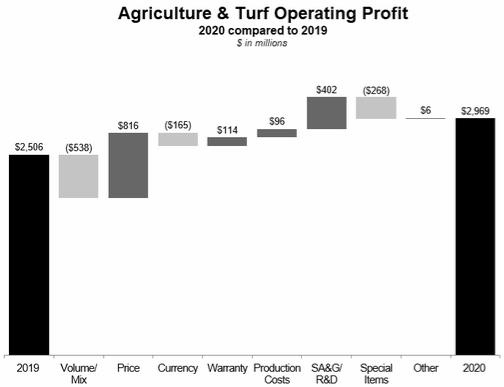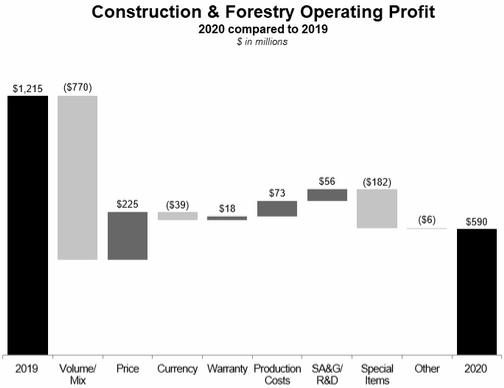sales, service, and administration office located in Nashville, Tennessee. In addition, the equipment operations operate a centralized parts distribution warehouse in coordination with ten regional parts depots and distribution centers in the U.S. and Canada.
Through these U.S. and Canadian facilities, John Deere markets products to approximately 1,981 dealer locations, most of which are independently owned and operated. Of these, approximately 1,544 sell agricultural equipment, while approximately 437 sell construction, earthmoving, material handling and/or forestry equipment. Nortrax owns some of the 437 dealer locations. Turf equipment is sold at most John Deere agricultural equipment locations, a few construction, earthmoving, material handling, and forestry equipment locations and about 358 turf-only locations, many of which also sell dissimilar lines of non-John Deere products. In addition, certain lawn and garden product lines are sold through The Home Depot and Lowe’s.
Outside the U.S. and Canada, John Deere agriculture and turf equipment is sold to distributors and dealers for resale in over 100 countries. Sales and administrative offices are located in Argentina, Australia, Brazil, China, France, Germany, India, Italy, Mexico, the Netherlands, Poland, Russia, Singapore, South Africa, Spain, Sweden, Thailand, Ukraine, and the United Kingdom. Turf equipment sales outside the U.S. and Canada occur primarily in Europe and Australia. Construction, earthmoving, material handling, and forestry equipment is sold to distributors and dealers primarily by sales offices located in Australia, Brazil, China, Finland, New Zealand, Russia, Singapore, and the United Kingdom. Some of these dealers are independently owned while John Deere owns others. Roadbuilding equipment is sold both directly to end customers as well as to independent distributors and dealers for resale. The Wirtgen Group operates company-owned sales and service subsidiaries in Australia, Austria, Belgium, Brazil, Bulgaria, China, Denmark, Estonia, Finland, France, Georgia, Germany, Guinea, Hungary, India, Ireland, Italy, Japan, Latvia, Lithuania, Malaysia, the Netherlands, Norway, the Philippines, Poland, Romania, Russia, Serbia, Singapore, South Africa, Sweden, Taiwan, Thailand, Turkey, Ukraine, and the United Kingdom.
The equipment operations operate centralized parts distribution warehouses in Brazil, Germany, India, and Russia in coordination with regional parts depots and distribution centers in Argentina, Australia, China, Mexico, South Africa, Sweden, and the United Kingdom.
John Deere markets engines, power train, and electronic components worldwide through select sales branches or directly to regional and global original equipment manufacturers and independently owned engine distributors.
Raw Materials
John Deere purchases raw materials and some manufactured components and replacement parts for its equipment, engines, and other products from leading suppliers both domestically and internationally. These materials and components include a variety of steel products, steel and iron castings, forgings, plastics, electronics, and ready-to-assemble components made to certain specifications. John Deere also purchases various goods and services used in production, logistics, offices, and research and development processes. John Deere maintains strategic sourcing models to meet its production needs and build upon long-term supplier relationships. John Deere uses a variety of agreements with suppliers intended to drive innovation, ensure availability and delivery of industry-leading quality raw materials and components, manage costs on a globally competitive basis, protect John Deere’s intellectual property, and minimize other supply-related risks. Supply chain risks monitored by John Deere to minimize the likelihood of the supply base causing business disruption include supplier financial viability, capacity, business continuity, quality, delivery, cyber security, and weather-related events, including natural disasters. In fiscal 2020, some of John Deere’s operations were temporarily impacted by certain material or component shortages due to the COVID-19 pandemic (COVID).
Backlog Orders
The dollar amount of backlog orders for the agriculture and turf segment believed to be firm was approximately $8.1 billion at November 1, 2020, compared with $5.5 billion at November 3, 2019. The agriculture and turf backlog is generally highest in the second and third quarters due to seasonal buying trends in these industries. The dollar amount of backlog orders for the construction and forestry segment believed to be firm was approximately $2.1 billion at November 1, 2020, compared with $1.7 billion at November 3, 2019. Backlog orders for the agricultural and turf and construction and forestry segments include all orders deemed to be firm as of the referenced date.
Trade Accounts and Notes Receivable
Trade accounts and notes receivable arise primarily from sales of goods to independent dealers. Most trade receivables originated by the equipment operations are purchased by the financial services operations. The equipment operations compensate the financial services operations at approximate market rates of interest for these receivables. Additional information appears in Note 13 to the Consolidated Financial Statements.

